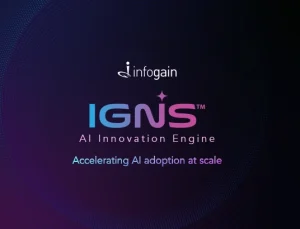- Posted on : July 20, 2020
-
- Industry : Retail
- Type: News

This is an authored article by Swaroop Rao, Vice President, Digital Engineering at Infogain that appeared in CIO Review India on July 13th, 2020.
To read the original article, please click here.
Over the past decade, retailers in India, and globally, have been deploying transformational solutions and technologies in their businesses to attract millennial and zillennial buyers and meet their high expectations of better experience and agility.
With COVID-19, several new challenges have emerged for the retail sector, which includes issues in the supply chain, drop in consumer demand, limited cash flows, ensuring safe and hygienic in-store operations, social distancing, contactless behavior, policy challenges, and government mandated lockdowns. In the current scenario, retailers in non F&B segments like apparel, home improvement, jewelry, etc. will be more impacted due to customers' shopping behaviors across these segments. As per a recent survey conducted by the Retailers Association of India (RAI), more than 95% of non-food retailers expect their revenues to reach only 40% of last year's revenues. Overall, less than 10% of medium and large retailers expect any profits till August 2020, while only 26% of small retailers expect to earn profits for the same period.
As the world resumes and markets re-open, retailers will need to follow a customer-centric approach, now more than ever, and invest in digital transformation not just to explore online sales but also to reinvent the in-store experience, while keeping in mind the new preferences and behaviors that the consumers will exhibit. Retailers will have to reimagine the customer journey map (CJM) to figure out the various (new) touchpoints, new front-end channels and recalibrate their approach for engaging customers so that they feel secure while shopping in-store.
At Infogain, we have been building digital business platforms and solutions for our customers, ensuring agility and responsiveness to the changing needs of their customers, by leveraging our expertise in human-centric design, analytics, mobility, and platform & cloud engineering. Here are 8 key solutions that can help with the resurgence of the retail sector in the post COVID economy.
1.Integrating Queue Management Systems(QMS)
Crowd management has become more important in a bid to achieve social distancing to prevent COVID-19, implementing Queue Management Systems or QMS will act as a measure of control, serving as one of the most relevant solutions in current times.
This solution is not just applicable to the retail segment but to pretty much every segment where a physical customer presence and engagement is relevant such as in banking, hospitals, and healthcare, retail, insurance, automotive, etc. The QMS solution can be enhanced to add additional features such as 'Promotion of the Day,' Deals, and Sponsors. The QMS system typically is hosted on the cloud with integration to customer backend systems of records - customer info, product catalog and promotions, and associated front-end systems. It can also address VIP customers and provide priority queues to service them. In some cases, customers can pre-authenticate themselves before they reach the store; this will enable the stores/service agents to support and personalize customer demands better, further ensuring that there is more bandwidth to service more customers than before especially in the situation of reduced staff
QMS will add considerable value and enhance the customer experience. It will become the next normal for the industry and will stay as an essential solution post COVID.
2.Dynamics of Mobility and E-Commerce
Retailers who have never thought of serving their customers through online channels or have never considered mobile as a channel will now have to rapidly build at least a light-weight online commerce site due to the COVID situation. These retail stores are typically in the boutique SMB segment, wherein customers are expecting their "trusted retailers," they have been buying from for years to deliver through online channels seamlessly. Some of the businesses that have online commerce channels have been unable to deliver in times of elevated online demand because of lack of backend modernization, obsolete product catalogs, lack of flexible payment channels, etc.
Therefore, such retailers will need to re-evaluate their approach to mobility and e-commerce with better online digital systems and create more intuitive platforms for attracting and retaining customers. In addition to this, as more retailers deploy e-commerce, we will see a surge in the integration of logistics/Delivery carrier platforms for the last mile delivery. This, too, will need tightly knit API integration into the existing systems to improve delivery efficiency.
3.BOPIS Integration
As the customer demands grow across locations, retailers will now face the challenge of managing the unified inventory and the ability to deliver products with more agility and flexibility. Some of the large retailers have been implementing BOPIS (Buy Online and Pick up In Store), while most of them still do not have this feature implemented. This calls for creating better Inventory visibility at the backend, smart decision logic to be able to get the SKUs shipped from the least cost paths of the warehouse/DC, etc. Existing online commerce sites and the order management systems (OMS), therefore, need to be assessed to check the feasibility of adapting to the BOPIS use cases. Retailers can explore simpler models to implement predetermined pickup locations for customers ordering online and gradually move towards smarter ways to implement for dynamic provisioning of locations and shipping.
While customers order online to pick up at their favorite stores, retailers will have to ensure that the stores are ready and well equipped to serve these customers picking up their orders. Call it Curb-Side Pickup/Return, but planning the appropriate technology and process is essential as customers cannot afford to wait in queues to pick up the orders as this could increase the risks associated with the COVID situation. Therefore, retailers need to think of applying the technology of Pick Up Lockers tagged with Bar Codes and enable customers with Self-Service on their mobile Apps to unlock the Bins. Other Use cases could be for customers to tap on a CALL BUTTON - or PUSH TO TALK on mobile apps when they are in the vicinity of the pickup location so that the Store associates can fetch the packages to the Curb or the designated parking lot. This can be possible by integrating the workflows with the associated tablet devices when the customer arrives by geo-tracking enablement. It will provide significant uplifts to customer experience and confidence to shop in the times of strict social distancing. Now, let us talk about certain situations where customers would like to engage physically to shop at stores. Typically, these are applicable for Apparels, Cosmetics, Spectacles/Eyewear, Jewellery retailers, amongst others. These retailers will need to find innovative approaches to make sure the customer confidence grows while maintaining social distancing and safety
4.Try N Buy Digitally
Customers typically like to try apparel before they decide. Now with the COVID situation, this is next to impossible. Magic Mirror Solutions integrated into the Buying Workflows will be very relevant in this situation.
A typical use case here would be of - A customer, while shopping, likes a dress and would like to try it out before they buy. The buyer scans the bar code of the dress on mobile and is allocated a trial room with a waiting Token number (QMS Solution is applicable here too!). The buyer walks into the trial room only when their token number appears on mobile. In the trial room, the buyer is provided with the options on the MAGIC MIRROR for the dress scanned. The customer will be able to try the dress virtually and may choose to try other recommended assortments/colors etc. and finalize the right choice to purchase. The buyer can then use the mobile to make the payment and walk out. Alternatively, buyers may choose to use one of the contactless self-checkout counters that interact with their mobile for easy checkout.
5.Virtual Make-Over
Similarly, Virtual Make-Over Applications customized for each store, the products catalog, payment is very relevant to the COVID situation. At the same time, customers would like to Try and Buy. The same applies to Eye Wear and Jeweller.
6.VR enabled shopping
This works best for customers who feel online shopping is monotonous and would like to experience the pleasure of physical shopping, along with family and friends. Retailers can explore the possibility of integrating Apple TV, Smart TV Applications, Voice, and Virtual Assistant to a shopper, that combines VR technologies to enable the customer to navigate the store aisle and get that in-store experience.
Apart from the customer-centric solutions, there are some areas where employee-focused solutions help enhance customer experience while also improving employee satisfaction:
7.Self-Healing POS and IT systems
Building better SRE and Observability of critical IT systems and POS as an example is vital to ensure there are no disruptions. POS systems failure can crowd up customer lines and can cause safety issues. Hence creating a predictive maintenance, prediction models for failure by implementing Observability and Reliability for such critical systems should be considered
8.IoT enablement
Systems that can be monitored remotely and maybe at high risk of failures should be assessed and enabled with IoT interfaces and automation. This will not only help better monitoring and management of the systems but also in ensuring efficiency and cost-saving while companies are running with depleted staff. For example, measuring the crowd behavior of customers at an aisle through video surveillance and analytics can help in optimized re-deployment of floor staff.
In conclusion, it can be said that the COVID -19 crisis has accelerated the need for retail as well as other segments where physical customer presence and engagement is relevant to adopt digital technologies, not just to sustain this neo-pandemic world, but to also improve their businesses. The crisis has also accelerated companies to shift to digital business models that they may have been considering with less urgency before, underlining the important role technology plays in consumers' lives as well as the role it serves for businesses that continue to adapt and operate under such conditions. And finally, technology is here to stay.






